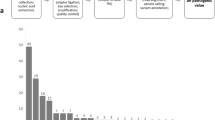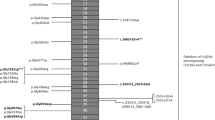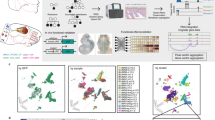Abstract
The involvement of genetic factors in the pathogenesis of KC has long been recognized but the identification of variants affecting the underlying protein functions has been challenging. In this study, we selected 34 candidate genes for KC based on previous whole-exome sequencing (WES) and the literature, and resequenced them in 745 KC patients and 810 ethnically matched controls from Belgium, France and Italy. Data analysis was performed using the single variant association test as well as gene-based mutation burden and variance components tests. In our study, we detected enrichment of genetic variation across multiple gene-based tests for the genes COL2A1, COL5A1, TNXB, and ZNF469. The top hit in the single variant association test was obtained for a common variant in the COL12A1 gene. These associations were consistently found across independent subpopulations. Interestingly, COL5A1, TNXB, ZNF469 and COL12A1 are all known Ehlers–Danlos Syndrome (EDS) genes. Though the co-occurrence of KC and EDS has been reported previously, this study is the first to demonstrate a consistent role of genetic variants in EDS genes in the etiology of KC. In conclusion, our data show a shared genetic etiology between KC and EDS, and clearly confirm the currently disputed role of ZNF469 in disease susceptibility for KC.
This is a preview of subscription content, access via your institution
Access options
Subscribe to this journal
Receive 12 print issues and online access
$259.00 per year
only $21.58 per issue
Buy this article
- Purchase on SpringerLink
- Instant access to full article PDF
Prices may be subject to local taxes which are calculated during checkout



Similar content being viewed by others
Data availability
The datasets generated and/or analyzed during the current study have been submitted to the European Genome-Phenome Archive, accession number EGAD00001006825.
References
Rabinowitz YS. Keratoconus. Surv Ophthalmol. 1998;42:297–319.
Godefrooij DA, de Wit GA, Uiterwaal CS, Imhof SM, Wisse RP. Age-specific incidence and prevalence of keratoconus: a nationwide registration study. Am J Ophthalmol. 2017;175:169–72.
Tuft SJ, Hassan H, George S, Frazer DG, Willoughby CE, Liskova P. Keratoconus in 18 pairs of twins. Acta Ophthalmol. 2012;90:e482–6.
Wang Y, Rabinowitz YS, Rotter JI, Yang H. Genetic epidemiological study of keratoconus: evidence for major gene determination. Am J Med Genet. 2000;93:403–9.
Szczotka-Flynn L, Slaughter M, McMahon T, Barr J, Edrington T, Fink B, et al. Disease severity and family history in keratoconus. Br J Ophthalmol. 2008;92:1108–11.
Morrow GL, Stein RM, Racine JS, Siegel-Bartelt J. Computerized videokeratography of keratoconus kindreds. Can J Ophthalmol J canadien d’ophtalmologie. 1997;32:233–43.
Kriszt A, Losonczy G, Berta A, Vereb G, Takacs L. Segregation analysis suggests that keratoconus is a complex non-mendelian disease. Acta Ophthalmol. 2014;92:e562–8.
Lu Y, Vitart V, Burdon KP, Khor CC, Bykhovskaya Y, Mirshahi A, et al. Genome-wide association analyses identify multiple loci associated with central corneal thickness and keratoconus. Nat Genet. 2013;45:155–63.
Toriello HV, Glover TW, Takahara K, Byers PH, Miller DE, Higgins JV, et al. A translocation interrupts the COL5A1 gene in a patient with Ehlers-Danlos syndrome and hypomelanosis of Ito. Nat Genet. 1996;13:361–5.
Segev F, Heon E, Cole WG, Wenstrup RJ, Young F, Slomovic AR, et al. Structural abnormalities of the cornea and lid resulting from collagen V mutations. Investig Ophthalmol Vis Sci. 2006;47:565–73.
Li X, Bykhovskaya Y, Canedo AL, Haritunians T, Siscovick D, Aldave AJ, et al. Genetic association of COL5A1 variants in keratoconus patients suggests a complex connection between corneal thinning and keratoconus. Investig Ophthalmol Vis Sci. 2013;54:2696–704.
Sahebjada S, Schache M, Richardson AJ, Snibson G, MacGregor S, Daniell M, et al. Evaluating the association between keratoconus and the corneal thickness genes in an independent Australian population. Investig Ophthalmol Vis Sci. 2013;54:8224–8.
Hao XD, Chen P, Chen ZL, Li SX, Wang Y. Evaluating the association between keratoconus and reported genetic loci in a Han Chinese population. Ophthalmic Genet. 2015;36:132–6.
Liskova P, Dudakova L, Krepelova A, Klema J, Hysi PG. Replication of SNP associations with keratoconus in a Czech cohort. PloS One. 2017;12:e0172365.
Rohrbach M, Spencer HL, Porter LF, Burkitt-Wright EM, Burer C, Janecke A, et al. ZNF469 frequently mutated in the brittle cornea syndrome (BCS) is a single exon gene possibly regulating the expression of several extracellular matrix components. Mol Genet Metab. 2013;109:289–95.
Moskvina V, Holmans P, Schmidt KM, Craddock N. Design of case-controls studies with unscreened controls. Ann Hum Genet. 2005;69:566–76.
Boyle EA, O’Roak BJ, Martin BK, Kumar A, Shendure J. MIPgen: optimized modeling and design of molecular inversion probes for targeted resequencing. Bioinformatics 2014;30:2670–2.
Udar N, Atilano SR, Brown DJ, Holguin B, Small K, Nesburn AB, et al. SOD1: a candidate gene for keratoconus. Investig Ophthalmol Vis Sci. 2006;47:3345–51.
O’Roak BJ, Vives L, Fu W, Egertson JD, Stanaway IB, Phelps IG, et al. Multiplex targeted sequencing identifies recurrently mutated genes in autism spectrum disorders. Science 2012;338:1619–22.
Dutta D, Gagliano Taliun SA, Weinstock JS, Zawistowski M, Sidore C, Fritsche LG, et al. Meta-MultiSKAT: Multiple phenotype meta-analysis for region-based association test. Genet Epidemiol. 2019;43:800–14.
Li B, Leal SM. Methods for detecting associations with rare variants for common diseases: application to analysis of sequence data. Am J Hum Genet. 2008;83:311–21.
Liu DJ, Leal SM. A novel adaptive method for the analysis of next-generation sequencing data to detect complex trait associations with rare variants due to gene main effects and interactions. PLoS Genet. 2010;6:e1001156.
Price AL, Kryukov GV, de Bakker PI, Purcell SM, Staples J, Wei LJ, et al. Pooled association tests for rare variants in exon-resequencing studies. Am J Hum Genet. 2010;86:832–8.
Ionita-Laza I, Lee S, Makarov V, Buxbaum JD, Lin X. Sequence kernel association tests for the combined effect of rare and common variants. Am J Hum Genet. 2013;92:841–53.
Neale BM, Rivas MA, Voight BF, Altshuler D, Devlin B, Orho-Melander M, et al. Testing for an unusual distribution of rare variants. PLoS Genet. 2011;7:e1001322.
San Lucas FA, Wang G, Scheet P, Peng B. Integrated annotation and analysis of genetic variants from next-generation sequencing studies with variant tools. Bioinformatics 2012;28:421–2.
Storey JD, Tibshirani R. Statistical significance for genomewide studies. Proc Natl Acad Sci USA. 2003;100:9440–5.
Lee S, Abecasis GR, Boehnke M, Lin X. Rare-variant association analysis: study designs and statistical tests. Am J Hum Genet. 2014;95:5–23.
Landers JA, Hewitt AW, Dimasi DP, Charlesworth JC, Straga T, Mills RA, et al. Heritability of central corneal thickness in nuclear families. Investig Ophthalmol Vis Sci. 2009;50:4087–90.
Swierkowska J, Gajecka M. Genetic factors influencing the reduction of central corneal thickness in disorders affecting the eye. Ophthalmic Genet. 2017;38:501–10.
Iglesias AI, Mishra A, Vitart V, Bykhovskaya Y, Hohn R, Springelkamp H, et al. Cross-ancestry genome-wide association analysis of corneal thickness strengthens link between complex and Mendelian eye diseases. Nat Commun. 2018;9:1864.
Brady AF, Demirdas S, Fournel-Gigleux S, Ghali N, Giunta C, Kapferer-Seebacher I, et al. The Ehlers-Danlos syndromes, rare types. Am J Med Genet Part C Semin Med Genet. 2017;175:70–115.
Graham SE, Nielsen JB, Zawistowski M, Zhou W, Fritsche LG, Gabrielsen ME, et al. Sex-specific and pleiotropic effects underlying kidney function identified from GWAS meta-analysis. Nat Commun. 2019;10:1847.
Huyghe JR, Bien SA, Harrison TA, Kang HM, Chen S, Schmit SL, et al. Discovery of common and rare genetic risk variants for colorectal cancer. Nat Genet. 2019;51:76–87.
Zweers MC, Bristow J, Steijlen PM, Dean WB, Hamel BC, Otero M, et al. Haploinsufficiency of TNXB is associated with hypermobility type of Ehlers-Danlos syndrome. Am J Hum Genet. 2003;73:214–7.
Schalkwijk J, Zweers MC, Steijlen PM, Dean WB, Taylor G, van Vlijmen IM, et al. A recessive form of the Ehlers-Danlos syndrome caused by tenascin-X deficiency. N Engl J Med. 2001;345:1167–75.
Nielsen JB, Thorolfsdottir RB, Fritsche LG, Zhou W, Skov MW, Graham SE, et al. Biobank-driven genomic discovery yields new insight into atrial fibrillation biology. Nat Genet. 2018;50:1234–9.
Zou Y, Zwolanek D, Izu Y, Gandhy S, Schreiber G, Brockmann K, et al. Recessive and dominant mutations in COL12A1 cause a novel EDS/myopathy overlap syndrome in humans and mice. Hum Mol Genet. 2014;23:2339–52.
Kuming BS, Joffe L. Ehlers-Danlos syndrome associated with keratoconus. A case report. South Afr Med J. 1977;52:403–5.
Woodward EG, Morris MT. Joint hypermobility in keratoconus. Ophthalmic Physiol Opt. 1990;10:360–2.
Street DA, Vinokur ET, Waring GO 3rd, Pollak SJ, Clements SD, Perkins JV. Lack of association between keratoconus, mitral valve prolapse, and joint hypermobility. Ophthalmology. 1991;98:170–6.
Knowlton RG, Weaver EJ, Struyk AF, Knobloch WH, King RA, Norris K, et al. Genetic linkage analysis of hereditary arthro-ophthalmopathy (Stickler syndrome) and the type II procollagen gene. Am J Hum Genet. 1989;45:681–8.
Walter K, Tansek M, Tobias ES, Ikegawa S, Coucke P, Hyland J, et al. COL2A1-related skeletal dysplasias with predominant metaphyseal involvement. Am J Med Genet Part A. 2007;143A:161–7.
McComish BJ, Sahebjada S, Bykhovskaya Y, Willoughby CE, Richardson AJ, Tenen A, et al. Association of genetic variation with keratoconus. JAMA Ophthalmol. 2020;138:174–81.
Funding
This study was supported by funding from the BELSPO-IAP program (project IAP P7/43-BeMGI to GVC), the FRO and Braille Liga. HV was supported by a PhD grant from the IWT (grant no. 131526). GVC was supported by the FWO (grant no. 12D1717N). VS was supported by a Bourse Rétina France 2013 and Bourse Rétina France 2017. The supporting organizations had no role in the design or conduct of this research.
Author information
Authors and Affiliations
Corresponding author
Ethics declarations
Conflict of interest
The authors declare no competing interests.
Additional information
Publisher’s note Springer Nature remains neutral with regard to jurisdictional claims in published maps and institutional affiliations.
Supplementary information
Rights and permissions
About this article
Cite this article
Fransen, E., Valgaeren, H., Janssens, K. et al. Resequencing of candidate genes for Keratoconus reveals a role for Ehlers–Danlos Syndrome genes. Eur J Hum Genet 29, 1745–1755 (2021). https://doi.org/10.1038/s41431-021-00849-2
Received:
Revised:
Accepted:
Published:
Issue date:
DOI: https://doi.org/10.1038/s41431-021-00849-2
This article is cited by
-
Keratoconus
Nature Reviews Disease Primers (2024)
-
Rare single nucleotide variants in COL5A1 promoter do not play a major role in keratoconus susceptibility associated with rs1536482
BMC Ophthalmology (2021)
-
Genomics elucidates both common and rare disease aetiology
European Journal of Human Genetics (2021)
-
A Panel-Based Sequencing Analysis of Patients with Paget’s Disease of Bone Suggests Enrichment of Rare Genetic Variation in regulators of NF-κB Signaling and Supports the Importance of the 7q33 Locus
Calcified Tissue International (2021)



